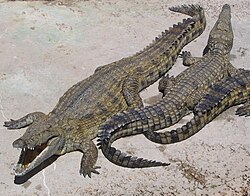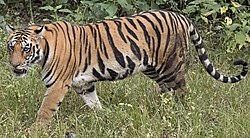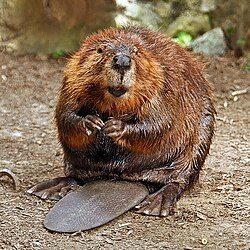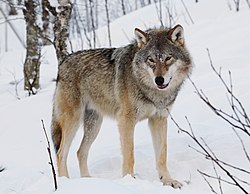List
| Family | Name | Binomial name | Image | Maximum lifespan |
|---|---|---|---|---|
| Alligatoridae | American alligator | Alligator mississippiensis | 87 years [3] [4] | |
| Cathartidae | Andean condor | Vultur gryphus | 80 years [5] | |
| Elephantidae | Asian elephant | Elephas maximus | 79.6 years [6] | |
| Corvidae | Common raven | Corvus corax | 69 years [7] | |
| Hominidae | Chimpanzee | Pan troglodytes | 68 years [8] | |
| Elephantidae | African bush elephant | Loxodonta africana | 65 years [9] | |
| Hippopotamidae | Hippopotamus | Hippopotamus amphibius | 61.2 years [10] | |
| Crocodylidae | Nile crocodile | Crocodylus niloticus | 56 years [11] | |
| Struthionidae | Ostrich | Struthio | 50 years [12] | |
| Accipitridae | Golden eagle | Aquila chrysaetos | 48 years [13] | |
| Rhinocerotidae | White rhinoceros | Ceratotherium simum | 45 years [14] | |
| Anatidae | Canada goose | Branta canadensis | 42 years [15] | |
| Boidae | Boa constrictor | Boa constrictor | 40.4 years [16] | |
| Ursidae | Grizzly bear | Ursus arctos horribilis | 40 years [17] | |
| Giraffidae | Giraffe | Giraffa camelopardalis | 39.5 years [18] | |
| Columbidae | Rock dove | Columba livia | 35 years [19] | |
| Bovidae | African buffalo | Syncerus caffer | 32.8 years [20] | |
| Camelidae | Dromedary camel | Camelus dromedarius | 28.4 years [21] | |
| Felidae | Jaguar | Panthera onca | 28 years [22] | |
| Felidae | Lion | Panthera leo | 28 years [23] | |
| Felidae | Cougar | Puma concolor | 27 years [24] | |
| Cervidae | Fallow deer | Cervus dama | 27 years [25] | |
| Felidae | Tiger | Panthera tigris | 26.3 years [26] | |
| Bovidae | Blackbuck | Antilope cervicapra | 23.9 years [27] | |
| Castoridae | American beaver | Castor canadensis | 23.4 years [28] | |
| Cervidae | Mule deer | Odocoileus hemionus | 22 years [29] | |
| Canidae | Red fox | Vulpes vulpes | 21.3 years [30] | |
| Canidae | Grey wolf | Canis lupus | 20.6 years [31] | |
| Mustelidae | Giant otter | Pteronura brasiliensis | 17.3 years [32] | |
| Bovidae | Pronghorn | Antilocapra americana | 15.5 years [33] |





























